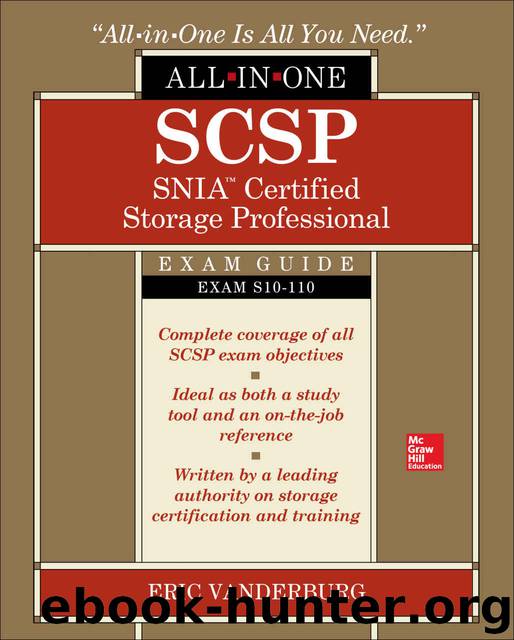SCSP SNIA Certified Storage Professional All-in-One Exam Guide (Exam S10-110) by Eric Vanderburg

Author:Eric Vanderburg [Vanderburg, Eric]
Language: eng
Format: azw3
Publisher: McGraw-Hill Education
Published: 2017-03-31T04:00:00+00:00
Backup Reliability Methods
Backup reliability is the level of assurance that backup processes will be able to restore data effectively. The first component of this is ensuring that data integrity is intact, meaning that data has not been altered or corrupted in the process of backing it up or restoring it. One method used to verify integrity is checksums. Next, application verification can be used to provide backup reliability.
Data Integrity
Data integrity refers to how data is maintained accurately and consistently over its entire lifecycle. It plays a vital aspect in the design, implementation, and use of a system used to store, process, or retrieve data. It is the opposite of data corruption, where data is lost during any process. Many aspects can affect data integrity that may differ under a certain context. Generally, though, it can be determined based on the following:
• Human error Errors people made while the data is entered
• Intentional actions Intentional harm to the integrity of data by attackers or malcontent employees
• Transmission error Errors that occur during the movement or transfer of data from one node to another or over the network
• Bugs The presence of software bugs or viruses
• Hardware malfunction The failure of one or more hardware components
• Natural disaster Occurrence events such as fires or floods
Data integrity also ensures that the files saved remain the same from the time the backup is recorded up to the time it’s retrieved. Any intended or unintended changes to the data made during storage, process, and retrieval can also affect integrity.
So, how is data integrity ensured? Physical controls such as controlling access to the area where the servers are kept by allowing only authorized users to get in and out of the area is the first step to ensuring data integrity from human error and intentional actions. This should be combined with specific authorization levels for all users. Other integrity concerns such as transmission errors, bugs, hardware malfunctions, and natural disasters are approached with documented system administration procedures, disaster-recovery plans, and incident response plans. Systems also employ integrity-checking features such as checksums and application verification, discussed next.
Download
This site does not store any files on its server. We only index and link to content provided by other sites. Please contact the content providers to delete copyright contents if any and email us, we'll remove relevant links or contents immediately.
Test-Driven iOS Development with Swift 4 by Dominik Hauser(7898)
Filmora Efficient Editing by Alexander Zacharias(6555)
The Infinite Retina by Robert Scoble Irena Cronin(6059)
Learn Wireshark - Fundamentals of Wireshark. by Lisa Bock(4388)
Linux Device Driver Development Cookbook by Rodolfo Giometti(4008)
Edit Like a Pro with iMovie by Regit(3820)
Linux Administration Best Practices by Scott Alan Miller(2927)
Linux Command Line and Shell Scripting Techniques by Vedran Dakic & Jasmin Redzepagic(2885)
Mastering PowerShell Scripting - Fourth Edition by Chris Dent(2779)
Creative Projects for Rust Programmers by Carlo Milanesi(2612)
MCSA Windows Server 2016 Study Guide: Exam 70-740 by William Panek(2568)
Docker on Windows by Stoneman Elton(2360)
Kali Linux - An Ethical Hacker's Cookbook: End-to-end penetration testing solutions by Sharma Himanshu(2351)
Hands-On AWS Penetration Testing with Kali Linux by Karl Gilbert(2189)
Hands-On Linux for Architects by Denis Salamanca(2119)
Computers For Seniors For Dummies by Nancy C. Muir(2092)
Programming in C (4th Edition) (Developer's Library) by Stephen G. Kochan(2081)
The Old New Thing by Raymond Chen(2033)
Linux Kernel Debugging by Kaiwan N Billimoria(1812)
